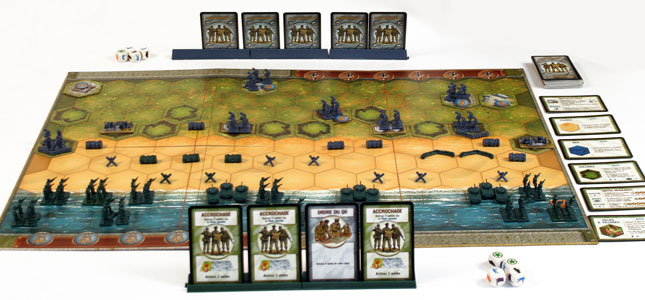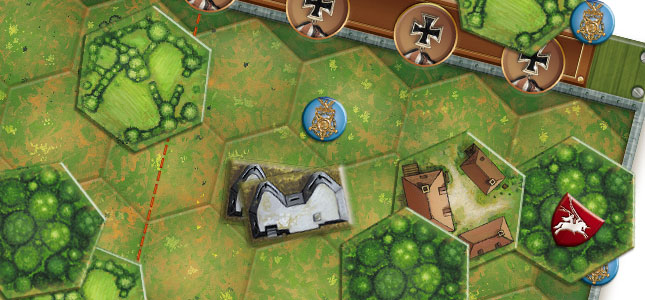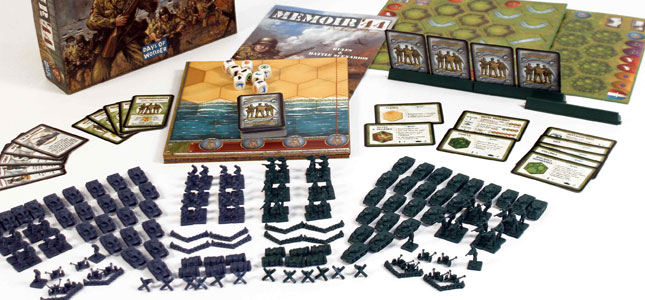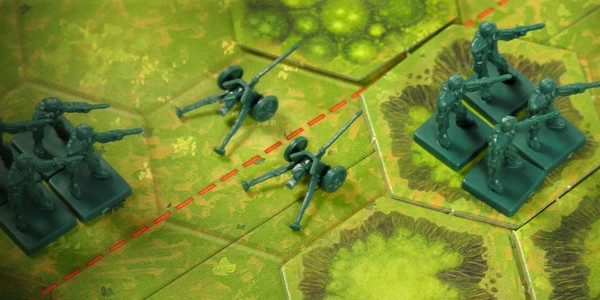 I am a World War II buff. My Netflix account is (perhaps disturbingly) a repository of World War II documentaries. I consume military history books with blind devotion. I got an HBO account solely to watch Tom Hank’s The Pacific. I’ve visited the remains of more than one concentration camp. And I was personally offended when my boyfriend didn’t find Band of Brothers addictive.
I am a World War II buff. My Netflix account is (perhaps disturbingly) a repository of World War II documentaries. I consume military history books with blind devotion. I got an HBO account solely to watch Tom Hank’s The Pacific. I’ve visited the remains of more than one concentration camp. And I was personally offended when my boyfriend didn’t find Band of Brothers addictive.
So I was thrilled beyond belief when I learned Memoir ’44 existed. The prospect of recreating the exact battles I had pored over (D-Day! Bastogne! Ardennes! Guadalcanal!) proved irresistible. Not to mention the opportunity to “rewrite” history, especially in battles where victory turned on a razor-thin margin. Removing the shrink wrap and opening the box for the first time was practically a spiritual experience.
The double-sided battlefield board (beach and countryside) is sturdy and smooth, its colors crisp and vibrant. The playing area itself is divided into three vertical sections, demarcated by red dotted lines meant to represent each player’s left flank, center, and right flank. The army miniatures are varied. The Allies (green) and Axis (blue-gray) are each allotted 42 infantry figures; 24 tanks; 6 artillery pieces; and 18 man-made obstacles, including barbed wire, sandbags, and hedgehogs. Each player also receives three cardholder sections, which can be linked to accommodate a greater number of cards.

Setting up the first scenario, Pegasus Bridge, is easy enough. I unwrap my 44 double-sided Terrain hex pieces, which include forest, hedgerow, hill, town, and river hexes. Each is detailed and cleanly printed. Following the illustrated scenario guide, I place them on the board, along with the obstacles specified in the scenario. The finished battlefield contains two rivers bisecting my left and right flanks, a pond in my center, a cluster of forests, and a smattering of towns. I place a bridge, as directed, over each river (rivers are otherwise impassable terrain) and a victory medal on each bridge. Next, I load the board with troops, carefully consulting the scenario guide to make sure that they are correctly placed. Six Allied and six Axis infantry units, each composed of four infantrymen, soon inhabit the board. We are ready to play.
The object of the game is—spoiler alert—to win the battle. In order to do so, a player must win the number of victory medals specified in the scenario booklet (ranging from four to six in the base game). Medals are achieved in one of two ways: by occupying a hex with a victory medal medallion until game end or eliminating the figures (two to four, depending on unit type) comprising an enemy unit. Six Axis and Allied crests line the bottom edge of each player’s side of the board and track the respective number of victory medals earned.
Winning the game depends on several factors, namely the number and type of Command cards one is dealt, the difficulty of the terrain, and the lethalness of the opposing army (measured by sheer number of troops or superiority of firepower). At game start, each player is dealt the number of cards dictated in the scenario booklet. For Pegasus Bridge, for example, the Axis player receives two command cards, the Allied player six (indicating a considerable Allied advantage). Turns proceed in the following sequence: play a Command card, order troops, move troops, battle, and replenish one’s hand. As in any of the games that utilize designer Richard Borg’s Commands and Colors system, Command cards are the heart of the game; they constrain one’s attacks and shape one’s strategy by specifying what actions one can take, in which section of the battlefield, and with how many troops. The strategy is in choosing what cards to play and when.

While Command cards are the heart of the game, battles are where the action’s at. To battle an enemy unit, it must be within battle range and line of sight. Battle ranges vary based on unit type; infantry and armor units have a maximum battle range of three hexes, artillery six. Moving units in order to attack opposing units can be tricky depending on surrounding terrain. Many terrain features, such as forests and hills, block line of sight, meaning a unit may not shoot through them. Terrain features may also impose battle restrictions. A unit moving into a hedgerow, for example, may not battle until its next turn. Terrain features may further limit battle capabilities. Battles are waged using six-sided battle dice, each side stamped with an infantry, armor, artillery, grenade, miss, or retreat symbol. A player’s roll determines whether and how many enemy troops are killed. If enemy troops enjoy terrain protection (by occupying a forest or hill hex, for example), an opponent’s battle dice are reduced accordingly upon attack.
While Memoir ’44 may strike diehard war gamers as somewhat simplistic, its characteristics make gameplay intense and rewarding. The game evokes urgency, determination, and trepidation. Lives are on the line. One grows surprisingly attached to one’s units, watching with increasing anxiety as they are eliminated by successful attacks or with elation when they successfully defeat opposing troops. Strategizing is an endeavor unto itself. One must capitalize on powerful Command cards and parlay less powerful ones into coherent attacks. A bad hand can turn the tide of war in a heartbeat. But the proportion of strong to weak Command cards seems thoughtfully designed. While unfavorable hands certainly do happen, more often than not players are neck and neck, or at least in the same ballpark. This inspires a surprising sense of camaraderie between competing players as they suffer losses and triumph in turn. Terrain features and obstacles add some spice to the mix and keep one on one’s toes. Should I enter this forest knowing I’ll lose my ability to battle and be subject to close assault during my opponent’s next turn? Should I leave the protection of these sandbags behind in order to advance? With you in command, contingent choices pile up with each turn, ratcheting up the intensity and culminating in a battle won or lost.
Overall, Memoir is fun in its destructive excitement (though somewhat somber in its theme), mentally engaging, and strategically challenging. The base game is a solid, reliable addition to any board game collection, although at least a mild interest in the historical background is probably necessary to make the game feel truly multidimensional. The scenarios are plentiful and can be downloaded free of charge from the Days of Wonder website. If one tires of preset scenarios, the game also accommodates scenarios dreamed up by imaginative players.

Of course, like any game, Memoir has its downsides. Setup can take up to 30 minutes based on the complexity of the battlefield. The base game only accommodates two players (although Days of Wonder insists it can be played in teams), and the rules are complicated enough to make it a young adult/adult game (although Days of Wonder, once again to the rescue, includes simplified rules for “Young Generals”). Players are warned that, because they are based on historical conditions, some battles will skew heavily in one player’s favor. While one may appreciate this effort at historical accuracy, lopsided scenarios can be frustrating and demoralizing in practice. Equally frustrating is the color scheme. The dark green Allied troops are surprisingly difficult to distinguish from their “blue-gray” Axis counterparts.
My main complaint, however, is the difficulty of integrating expansion packs. I may have moved hastily in attempting to do so, thrilled as I was about the game’s existence, but adding new rules and miniatures tended to triple match time and add tedium. This is in part because some rules, like those accompanying the Air Pack (now out of print), are confusingly written. (This is in contrast to the base rules, which, according to my board-game-obsessed Editor-in-Chief are “some of the best written rules I’ve seen.” I agree.) Acquired fluency in the base game alleviates this difficulty.
Lastly, I’ll offer a word to the wise spender. While the expansion packs are worthwhile for those of us who like to bring a bit of realism to our miniature World War II reenactments (who wants to play a winter battle on a verdant board?), they are gimmicky and not strictly necessary. Axis troops can substitute for Japanese miniatures, for example, and winter and desert battles can be played (albeit unrealistically) on a countryside board.
Realism aside, Memoir ’44 gives your brain a little something to chew on when it’s hungry for strategic combat.


















